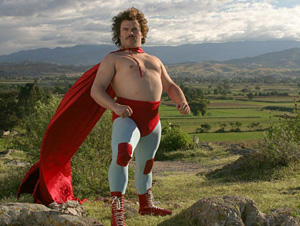 |
 |
 |
 Entertainment | August 2006 Entertainment | August 2006  
'Nacho Libre' a Smackdown Hit in Mexico
 Colin McMahon - Chicago Tribune Colin McMahon - Chicago Tribune


| | To film critic Jose Luis Ortega Torres, it is the respect for that genre and the respect for lucha libre and its Mexican fans that makes "Nacho Libre" work. |
Mexican wrestling fans can spot a fake a kilometer away. And when they disapprove of a ring performance in the sport they call lucha libre, they can be merciless.

But the American movie star Jack Black turns out to be the real deal. Playing a Mexican monk turned professional wrestler in the comedy "Nacho Libre," Black has won over not just movie fans but also lucha libre buffs with a performance that Mexicans say captures both the fun and the heart of their beloved sport.

"Nacho Libre" opened this month to positive, if not glowing, reviews, strong ticket sales and knowing laughs from wrestling aficionados such as Marco Antonio Morales.

"It was extremely entertaining," said Morales, 40, a Mexico City architect. "The lucha libre portrayed in the movie was like it was in the old days, before the pro wrestling of the United States got so big and affected Mexico."

For Morales and Carmela Perez, a 38-year-old lawyer, the movie also depicted Mexico and Mexicans in a more realistic way than most Hollywood fare.

"I don't know where they found some of those actors, but they were perfect," Perez said. She could see, however, why the Roman Catholic Church might not like the film.

Jared Hess, who made his debut with the independent hit "Napoleon Dynamite," directed and co-wrote "Nacho Libre." He shot the film and found some of its players in the southern Mexican state of Oaxaca.

Hess said he became fascinated with Mexican lucha libre as a teenager in Idaho. He caught a late-night movie on television starring the most famous of Latin American wrestlers, Santo, and was hooked, Hess said in a series of published interviews to promote the June release of "Nacho Libre" in the U.S.

Hess then tracked down more movies starring Santo, Blue Demon and other Mexican icons during the golden period of lucha libre in the 1960s and into the 1970s. When the chance came to make a movie inspired by a real-life Mexican priest who wrestled professionally to fund an orphanage, Hess jumped.

That priest, the Rev. Sergio Gutierrez Benitez, wrestled more than 4,000 bouts under the name Fray Tormenta, or Brother Storm.

Invited by the Mexico City newspaper Reforma to view "Nacho Libre," the priest gave it his blessing.

"I was a fatty too, and, like Jack, I had a lot of agility in the way I could jump around from here to there," Fray Tormenta, now 54, told Reforma.

On the Friday night that "Nacho Libre" opened in Mexico, crowds packed into a daunting multiplex at a shopping mall in southern Mexico City.

There for the late show were Enrique Palafox and Gabriel Ramirez, designers by profession but film scholars on the side. Their niche is cult movies, and lately they have turned their attention to Mexican wrestling pictures starring Santo, Blue Demon and others.

During his heyday, Santo, the Silver Masked Man, starred in as many as four or five movies a year. In pictures such as "Brain of Evil" and "Santo Versus the Zombies," the wrestler took on monsters, mad scientists and, unforgettably, mummies who had come back to life in Guanajuato.

Santo died in 1984 and was buried in his mask.

"It really captured the magic of the movies of Santo," Palafox said of "Nacho Libre." "It could be seen as an homage."

Ramirez praised the casting as "brutal," meaning, in this case, tremendous. And he enjoyed the high Hollywood production values and skillful action sequences that Hess brought to a genre dominated by tiny budgets and tired staging.

To film critic Jose Luis Ortega Torres, it is the respect for that genre and the respect for lucha libre and its Mexican fans that makes "Nacho Libre" work.

For one thing, Ortega Torres said, Hess understands the importance of the masks that wrestlers wear.

"The film is honest. It is knowing about the implications of putting on a mask, which is so important to Mexican culture going back to pre-Hispanic times," Ortega Torres said. "You put on a mask and you are invincible, for good or bad."

Mexican wrestling heroes almost invariably come from the working class. And unlike its glitzy and bombastic cousin to the north, Mexican pro wrestling is peopled not just by sculpted brutes but often by regular people with regular bodies who just happen to be leading double lives in wild costumes.

Black pulls that off with his character Ignacio.

"He is small and round, a figure much closer to us," Ortega Torres said. "But with a heart as big as his stomach."

"The respect for lucha libre is always there in the movie. There are some very funny spots, and there are figures they poke fun at. But it's not mocking. It's not insulting. It's done with a dignity for the sport." | 
 | |
 |



